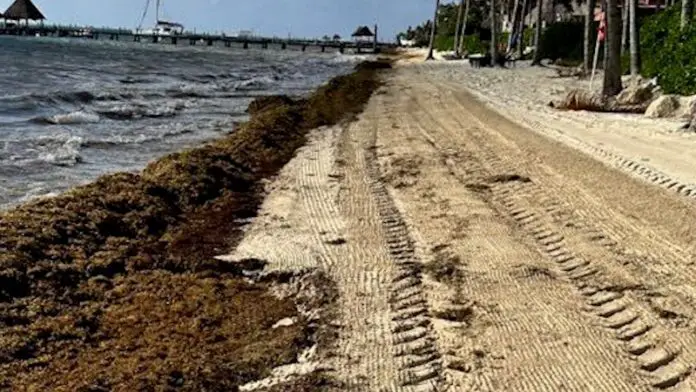An unprecedented 31 million tons of foul-smelling seaweed is drifting towards Florida and Mexican shorelines, alarming tourism operators in some of the world’s most popular beach destinations.
Sargassum mats have already been spotted coating marinas in Miami-Dade and piling up along Key Biscayne. In Mexico’s Quintana Roo state, which includes top tourist spots like Playa del Carmen, Puerto Morelos, and Tulum, authorities are deploying navy-led cleanup operations and floating barriers to protect the prized coastlines.
In open ocean waters, sargassum supports marine life; however, once onshore it becomes toxic, smothering marine ecosystems, emitting noxious gases such as hydrogen sulfide and ammonia during decomposition. This process turns once picturesque beaches into foul-smelling eyesores. Sargassum typically washes up between March and October.
According to calculations from the University of South Florida’s Optical Oceanography Lab, this year’s bloom in the tropical Atlantic and Caribbean seas has shattered previous records by a massive margin.
“It’s huge,” Dr. Chuanmin Hu, Professor of Oceanography at USF’s College of Marine Science, stated. “Typically, if it’s just 5% or 10% over a record, it’s not big. But now we see 40% higher than historical records.”
Experts warn that the worst may still be ahead, with more growth expected through the summer.
For tourism-dependent destinations, even one unpleasant encounter with the stinking seaweed can deter visitors from returning — potentially forever. “The tourists check out, and they don’t come back,” Brian LaPointe, a research professor at Florida Atlantic University’s Harbor Branch Oceanographic Institute, said.
While resorts use machinery to collect the seaweed, these efforts may add their own pollution.
Experts say the size of this year’s bloom has been supercharged by warming oceans and excess nitrogen from agricultural runoff — factors that are transforming a natural phenomenon into a full-blown crisis.
Resorts face rising cleanup costs, lower bookings, and reputation risk if the sargassum continues to blanket shorelines. To combat it, the Mexican Navy is collaborating with the state of Quintana Roo to collect sargassum at sea before it reaches shore.
One nearly six-mile-long floating barrier has been installed off beaches in Quintana Roo like Mahahual, Playa del Carmen, and Puerto Morelos.
In a longer-term solution being explored, researchers propose using sargassum as a natural tool for carbon capture and storage. The idea is to harvest the excess seaweed and sink it to the ocean floor, where the carbon it holds could remain locked away for hundreds or even thousands of years.
This process, known as ocean-based carbon sequestration, could help reduce levels of carbon dioxide in the atmosphere — a major driver of climate change.
Source: Open Jaw




